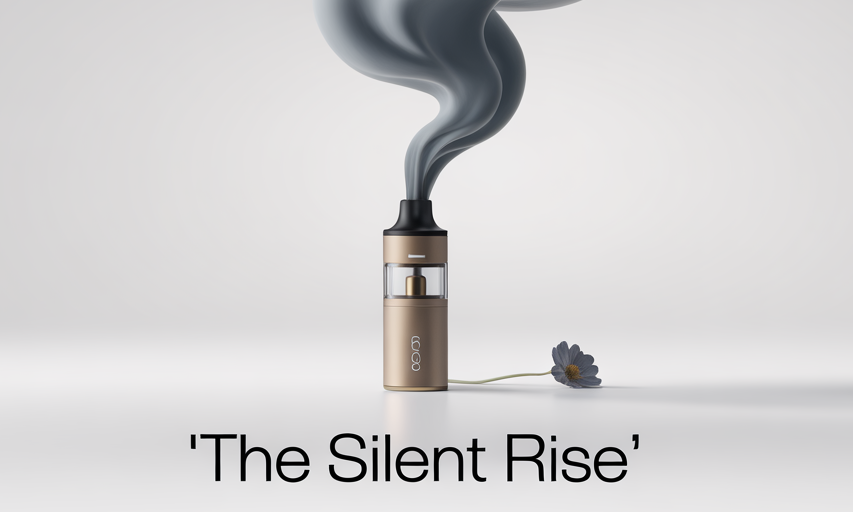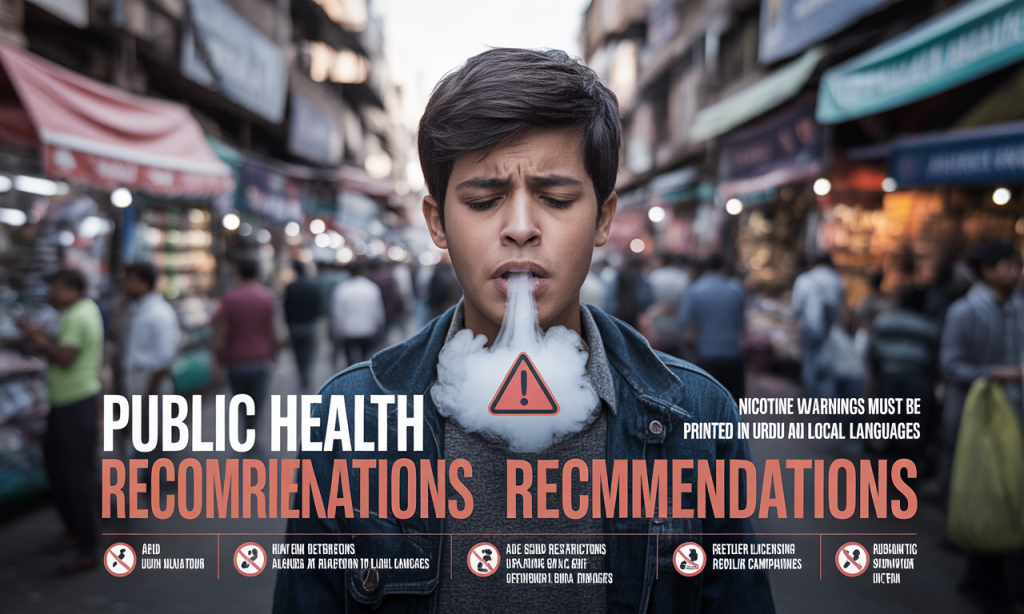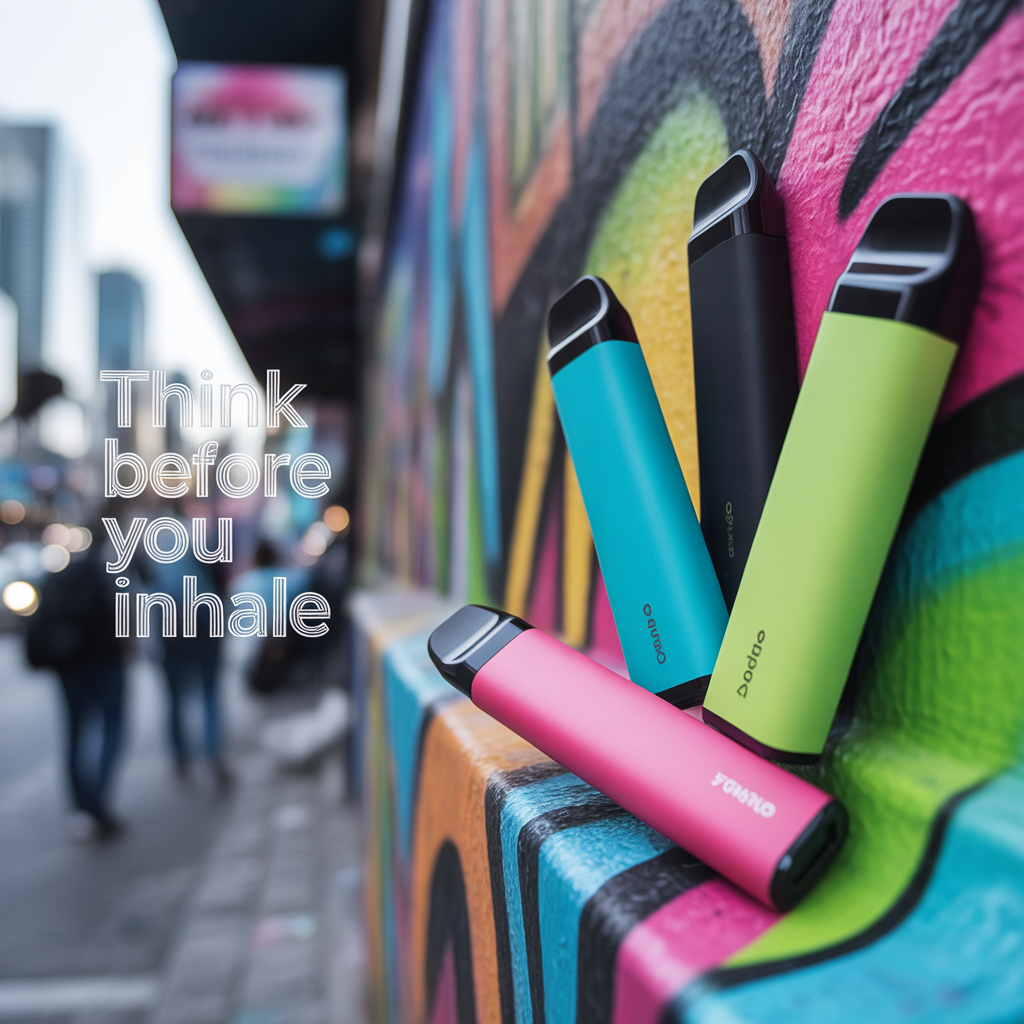At face value, the colorful vapes in fruity or dessert flavors might seem like nothing but a harmless trend. In Pakistani metropolitan cities, Karachi’s chi-chi cafes, perhaps, or Lahore’s all-night haunts, young people are often spotted allowing plumes of mango, mint, or cola-scented vapour to curl around them, their feet propped up on rickety chairs as they chat with friends. These enticing scents, sexy packaging, and cool packaging are a carefully crafted, global marketing strategy that has subtly infiltrated Pakistani youth culture. But beneath the sugar-sweet image is something much more harmful: flavoured vapes may be producing a new generation of nicotine addicts in Pakistan, with minimal awareness and almost no regulation.
Vaping in Pakistan: Under the Radar
Vaping – electronic nicotine delivery systems (ENDS) – was first promoted worldwide as an ostensibly “safer” alternative to customary cigarettes. In Pakistan, where more than 24 million people already smoke, e-cigarettes have been quietly coming in over the past decade, mostly at upmarket stores or online platforms. They had grown, but not nearly as quickly as they did due to the privacy and regulatory vacuum.
E-cigarettes are not federally barred and barely subject to import checks, making them widely accessible online, as well as at kiosks in shopping malls or even in stationery stores, often without age barriers. What’s concerning isn’t the accessibility; it’s the widespread appeal they have gained among children and teenagers.
What Makes Flavoured Vapes So Popular?
Flavored vapes are the Trojan horse of nicotine addiction. Their fruity, minty, or sweet flavours mask the bitter taste of nicotine, making the substance more attractive for newcomers. A 13-year-old might gag at the taste of a cigarette, but bubblegum- or watermelon-flavoured vapour? That’s a different story.
Here’s why these flavours are so appealing:
- Taste and Smell: Unlike traditional tobacco, flavoured vapes offer a sensory experience that appeals to teenagers and young adults.
- Packaging: Bright, colourful packaging resembles candy wrappers or soft drink cans—intentionally designed to attract younger consumers.
- Discreet Use: The absence of the lingering tobacco smell allows students to use them undetected at schools or universities.
- Social Media Influence: Instagram and TikTok have glamorized vape culture, with influencers showing off ‘cloud tricks’ or reviewing new flavours.
- Peer Pressure and Status Symbol: For urban teens, owning a flashy vape device is sometimes seen as trendy or rebellious.
The Silent Rise of Nicotine Addiction

Thousands of people wrongly believe that vapes are harmless, or certainly much less damaging to health than drugs. But this is far from the case, especially concerning addiction to nicotine.
Nicotine, the primary psychoactive ingredient in most vapes, is highly addictive. Flavoured vapes tend to have higher nicotine levels than traditional cigarettes, particularly in devices that use nicotine salts. Teens are especially susceptible: Their still-developing brains are more vulnerable to nicotine’s addictive effects, and early use places them at higher risk of becoming lifelong addicts.
Teachers in schools and colleges are reporting an increase in behavioural problems involving vaping. Students are irritable, panicky, and have trouble concentrating, the classic symptoms of nicotine withdrawal.
Vaping Myths vs. Reality
| Myth | Reality |
| Vaping is safer than smoking | It may reduce some toxins found in cigarettes, but it still carries msignificanthealth risks |
| Vapes don’t contain nicotine | Most flavoured vapes contain high levels of nicotine |
| It’s just vapour, not smoke | Vapour contains ultrafine particles, heavy metals, and harmful chemicals |
| Vaping helps people quit smoking | In Pakistan, many non-smokers (especially youth) begin with vaping, not cigarettes |
| It’s harmless for teens | Nicotine alters brain development, affecting memory, mood, and learning |
In 2019, the U.S. Centers for Disease Control and Prevention (CDC) reported an outbreak of e-cigarette, or vaping, product use-associated lung injury (EVALI), which resulted in thousands of hospitalizations and deaths — many from illicit or flavored vape products. Pakistan has no central database to monitor such incidents, so the actual health burden here is unclear.
Regulatory Black Hole
At present, Pakistan does not have clear laws when it comes to the sale, distribution, and advertising of vaping products. Tobacco products are banned under Pthe rohibition of Smoking and Protection of Non-Smokers’ Health Ordinance 2002, but ecigs are in a no-man’s land. Private institutions have tried to impose bans, but enforcement has been feeble.
- Lack of age verification and advertising restrictions has ushered in a world where:
- Kids can purchase vapes effortlessly with cash at corner stores or online
- Vape brands’ use of influencer marketing remains unregulated
- Taste and branding are specifically geared to youth
- Health warnings are either missing or unreadable.
- With no local research and public awareness, it becomes challenging to make informed policy decisions.
A Global Perspective: Lessons for Pakistan
Countries across the world have begun cracking down on flavoured vapes:
- India: Completely banned e-cigarettes in 2019.
- USA: Banned flavoured pods (except menthol and tobacco) and imposed strict age-verification rules.
- Australia: Made it illegal to import nicotine vapes without a doctor’s prescription.
- UK: Announced plans to ban disposable flavoured vapes and restrict youth-oriented advertising.
Pakistan must pay attention to these global precedents. The longer we wait, the more entrenched vaping will become among Pakistani youth.
Parents’ Responsibilities and Educators’ Duties
The first principle of defense is awareness that public opinion is the first line of defense. Signs that a child is vaping. Not everybody knows the signs of vape use and addiction, but it’s essential. Here’s what they can do:
- peer pressure.
- Monitor Behaviour: Look out for sudden changes in mood, grades, sleep, orthe smell of fruit/candy in bedrooms.
- Limit Access: Block online purchase options and report illegal vendors selling to minors.
- Create Support Systems: Help teens deal with stress or anxiety through healthier coping strategies.
Schools can incorporate anti-vaping sessions into health education, just like traditional anti-smoking campaigns.
Public Health Recommendations

To prevent a full-scale crisis, urgent steps must be taken:
- Ban on Flavoured Vapes: Especially those designed to appeal to minors.
- Age Restrictions: Enforce legal purchasing age of 18 or above, with mandatory ID checks.
- Retailer Licensing: Vendors must be regulated and penalized for illegal sales.
- Public Campaigns: Educate people about the real risks of vaping, especially on social media platforms.
- Tax and Pricing Controls: Make vapes less financially accessible to youth.
- Clear Labeling: Nicotine warnings must be printed in Urdu and local languages.
- Research and Data: Fund studies to assess the actual impact of vaping in Pakistan.
Wake-Up Call for the Nation
Pakistan is teetering on the brink of a public health catastrophe. Flavoured vapes, with their vivid packaging and deceptive sweetness, have already entered the lives of millions of teens and young adults. This could, if unchecked, lead to a new wave of nicotine addiction, an addiction that would be even more difficult to identify, treat, and one that would not result in cutting smoking rates.
The time to act is now. We have to put the health and safety of our youth ahead of corporate profits or social fads as a society. This isn’t a cool habit or some kind of hip lifestyle; it’s a ticking time bomb, wrapped in fruit-flavoured smoke.
